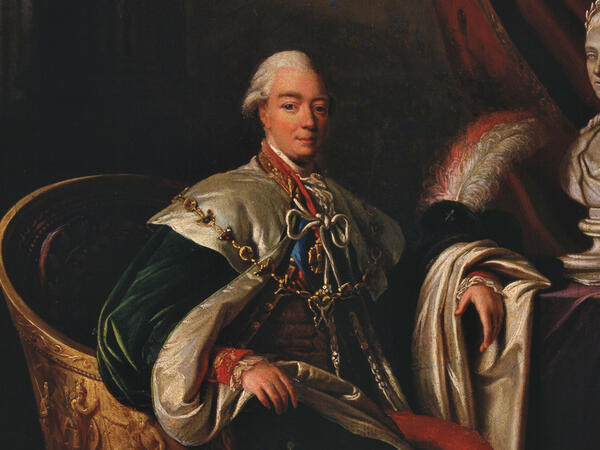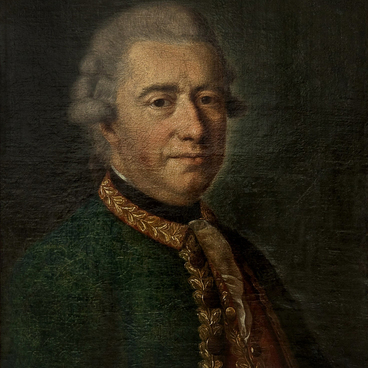Count Zakhar Chernyshev — a public official, a field-marshal-general, and a diplomat who became famous during the Seven Years’ War — is depicted on the portrait. He was born in 1722, in the family of the General-en-Chef Grigory Chernyshev and Avdotya Chernysheva, one of metressas (favorites) of the Emperor Peter the Great. There are memories of their contemporaries about the nickname the emperor gave her, which was “Avdotya the battleaxe”.
In 1763-1774, Zakhar Chernyshev was the head of the Military department. He was the first governor-general of Belarus and the governor-general of Moscow. During the coronation of the Empress Catherine II, Chernyshev carried out the main master of ceremonies duties, after which he was awarded the Order of St. Andrew the Apostle the First-Called.
During the Seven Years’ War, he distinguished himself in the Battle of Zorndorf, in which he commanded the grenadier troops. During the battle, Count Chernyshev had two horses wounded while riding, lost his adjutants, and finally was captured as a war prisoner near Kvartchen. That same autumn, after exchange of captives, he returned to the Russian army and commanded the corps of 20 thousand people, one of the units of which seized Berlin in 1760.
On the ceremonial portrait, Chernyshev is depicted wearing the mantle, the sash of The Order of St. Andrew, and the Order of St. Alexander Nevsky. The Count sits in the gilded armchair. The red suit is covered with the green velvet mantle lined with satin, to which the gold chain decorated with precious stones is attached. The painter depicted the black hat with a feather next to the Count and the portrait sculpture of the Empress Catherine II on the table.
The painting belongs to the classicism art. The colors are thick and intensive, the lines are straight and clear, the composition is modest and well-balanced.
In the second part of the 18th century, the dominant style of the Russian art was classicism. The portrait genre reached its full flowering. The ceremonial portraits were not supposed to represent the person, but the citizen, the servant of his Fatherland, the enlightened public official. As a rule, characters of such paintings were depicted in a study or traditional classicism decorations with draperies as in the portrait of Chernyshev.
The same portrait of a bigger size depicting Chernyshev is housed in the Arkhangelskoye Museum Estate. These paintings have the same prototype, which is the portrait from the collection of the State Hermitage Museum painted by Swedish artist Alexander Roslin. The Volgograd Museum named after I. I. Mashkov received the painting as a part of the collection donated by Nina Arning-Zaitseva.
In 1763-1774, Zakhar Chernyshev was the head of the Military department. He was the first governor-general of Belarus and the governor-general of Moscow. During the coronation of the Empress Catherine II, Chernyshev carried out the main master of ceremonies duties, after which he was awarded the Order of St. Andrew the Apostle the First-Called.
During the Seven Years’ War, he distinguished himself in the Battle of Zorndorf, in which he commanded the grenadier troops. During the battle, Count Chernyshev had two horses wounded while riding, lost his adjutants, and finally was captured as a war prisoner near Kvartchen. That same autumn, after exchange of captives, he returned to the Russian army and commanded the corps of 20 thousand people, one of the units of which seized Berlin in 1760.
On the ceremonial portrait, Chernyshev is depicted wearing the mantle, the sash of The Order of St. Andrew, and the Order of St. Alexander Nevsky. The Count sits in the gilded armchair. The red suit is covered with the green velvet mantle lined with satin, to which the gold chain decorated with precious stones is attached. The painter depicted the black hat with a feather next to the Count and the portrait sculpture of the Empress Catherine II on the table.
The painting belongs to the classicism art. The colors are thick and intensive, the lines are straight and clear, the composition is modest and well-balanced.
In the second part of the 18th century, the dominant style of the Russian art was classicism. The portrait genre reached its full flowering. The ceremonial portraits were not supposed to represent the person, but the citizen, the servant of his Fatherland, the enlightened public official. As a rule, characters of such paintings were depicted in a study or traditional classicism decorations with draperies as in the portrait of Chernyshev.
The same portrait of a bigger size depicting Chernyshev is housed in the Arkhangelskoye Museum Estate. These paintings have the same prototype, which is the portrait from the collection of the State Hermitage Museum painted by Swedish artist Alexander Roslin. The Volgograd Museum named after I. I. Mashkov received the painting as a part of the collection donated by Nina Arning-Zaitseva.



